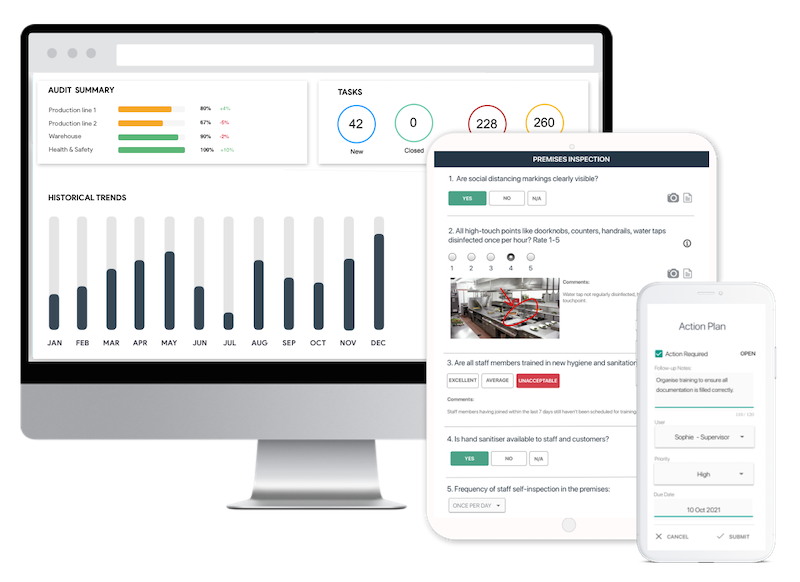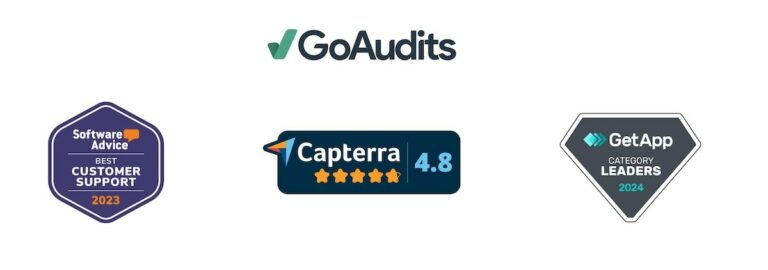Free Downloadable Professional Cleaning Checklists
Template Library > Property Inspection Templates > Professional Cleaning Checklists
Get Started With Ready-to-Use Professional Cleaning Checklists
A professional cleaning checklist helps your team stay on track, maintain standards, and simplify daily operations. For effective facility management & audits, start by mapping out key areas, list tasks by frequency, and assign them to the right people.
Used by cleaning staff, facility managers, and operations teams, these checklists bring structure to everyday tasks. Whether it’s a daily wipe-down or a weekly clean, a professional cleaner checklist ensures everything gets done, and nothing slips through the cracks.
With the GoAudits Property Inspection App, you can:
- Eliminate paperwork: conduct efficient digital audits, add photos from mobile device
- Customize this template or easily create your own
- Save time with instant reports & assign corrective actions
Kitchen
Bathrooms
Bedrooms
Living Area
Kitchen
Bathrooms
Bedrooms
Living Area
Save Time with Digital Inspections
- Easily capture & attach photos, directly on your mobile device.
- Instantly generate and share detailed reports after the inspection.
- Track corrective actions, view historical trends, improve standards.
What is a Professional Cleaning Checklist?
A professional cleaning checklist is a structured guide that outlines the tasks, areas, and standards involved in maintaining a clean and hygienic environment. Unlike casual cleaning routines, it’s designed for commercial or specialized settings where cleanliness directly impacts safety, compliance, or customer perception.
This type of checklist helps cleaning staff follow a consistent process—covering everything from surface cleaning and floor care to waste disposal and sanitization of high-touch points. It can be tailored to different industries like hospitality, healthcare, retail, or office cleaning.
Using a professional cleaning checklist helps:
- Ensure all areas are cleaned thoroughly and consistently.
- Reduce oversight by standardizing daily, weekly, and periodic cleaning tasks.
- Provide clear documentation for internal reviews or client reporting.
Why Structured Cleaning Processes Matter in Professional Settings
In a professional setting, cleaning isn’t just about appearance but it’s also tied to safety, compliance, and reputation. A structured cleaning process ensures high standards are met consistently, no matter the setting. Here’s why it matters:
Maintains a Safe and Healthy Environment
Workplaces and public facilities see a lot of movement. Without a structured cleaning routine, bacteria, allergens, and contaminants can build up quickly. Standardized processes help ensure that high-touch areas, shared equipment, and common spaces are cleaned thoroughly and regularly, reducing the risk of illness or accidents.
Ensures Task Coverage and Reduces Oversight
In fast-paced workplaces, it’s easy to overlook less visible tasks like cleaning behind equipment or disinfecting switches and handles. A structured process breaks cleaning down into clear, repeatable steps, making sure nothing is missed, no matter how busy the day is or who is doing the job.
Increases Efficiency and Team Coordination
Cleaning teams often work across multiple shifts or locations. A structured approach keeps everyone on the same page, avoiding duplication of effort or missed areas. It also allows new team members to get up to speed quickly without constant supervision.
Reinforces Brand Standards and Professionalism
A clean space reflects on your business. Whether it is a public hotel area, retail store, clinic, or office, a visible commitment to cleanliness supports your brand image. Structured processes help ensure that presentation and hygiene remain consistent, reinforcing trust with customers, clients, and staff.
Common Professional Cleaning Oversights and How to Prevent Them
Even with routine cleaning in place, certain areas are easy to miss. These oversights often happen because the spots aren’t obvious, aren’t used frequently, or are considered someone else’s responsibility. But if left unchecked, these oversights can add up, leading to hygiene problems, safety risks, and a negative impression on customers or staff.
Commonly Overlooked Areas:
- High-touch, low-visibility surfaces: Items like elevator buttons, handrails, drawer handles, and light switches are touched frequently but don’t visibly show dirt, making them easy to overlook.
- Behind and underneath equipment: Spaces behind fridges, under printers or copiers, and beneath coffee machines or vending units often accumulate dust, crumbs, and even pests.
- Air vents, ceiling fans, and corners: These spots are above eye level and out of reach, so they’re not included in standard cleaning passes.
- Shared technology and electronics: Items like keyboards, remotes, tablets, and touchscreen kiosks are passed from person to person.
- Baseboards, corners, and wall edges: These low-traffic zones tend to trap dust, hair, and debris over time. While they might not seem urgent, their gradual build-up can cause musty smells or attract insects.
- Light fixtures and overhead surfaces: Ceiling lights, hanging fixtures, and ducts tend to gather dust, insects, and cobwebs. Especially in places with high ceilings (like showrooms, restaurant cleaning procedures, and warehouse cleaning checks can be made mandatory to ensure hygiene across all areas.
- Window tracks and door frames: These narrow spaces collect dirt, mold, and grime, especially during seasonal weather changes. In environments with high humidity or foot traffic, these overlooked areas can lead to water damage or mold growth.
How to Prevent These Oversights with Cleaning Task Lists for Professionals
To consistently catch and clean these hard-to-spot areas, teams need proper structure and not just verbal reminders. Here’s how to build that into your cleaning process:
- Implement zone-based cleaning checklists: Break down the facility into zones, such as reception, workstations, kitchens, restrooms, and storage. Assign responsibilities per zone and make sure each list includes detailed surface types and hidden areas.
- Assign tasks based on cleaning frequency: Not all tasks need to be done daily, but listing them by cadence such as daily, weekly, monthly, or quarterly, ensures that rarely handled jobs (like air vent cleaning or behind-equipment vacuuming) are accounted for.
- Include spot checks and visual verification: Designate supervisors or team leads to perform routine walk-throughs focused specifically on hard-to-see or commonly skipped areas. This encourages accountability and helps identify patterns or recurring issues.
- Educate the team on the ‘why’ behind each task: It’s easier to clean thoroughly when teams understand the purpose. Provide short training or tooltips that explain why certain areas matter, from hygiene to safety to customer perception. This builds a stronger cleaning culture and encourages attention to detail.
By identifying and systematically addressing these oversights, cleaning teams can move from reactive to proactive. It’s not just about doing more, it’s about cleaning smarter, with better visibility into what’s truly getting done and what might be slipping through the cracks.
Cross-Department Professional Cleaning Responsibilities
Cleaning is rarely the job of a single team. In most professional settings, responsibilities are spread across departments, shifts, and even individual employees. Without clear boundaries, tasks can be duplicated, missed entirely, or trigger workplace friction.
Facilities/Maintenance teams usually lead cleaning efforts—handling floors, restrooms, HVAC filters, and any specialized sanitation of tools or equipment.
Operations are responsible for cleanliness in production areas, warehouses, or workstations. Regular wipe-downs, spill management, and equipment hygiene are key.
HR or Training departments ensure that cleaning protocols are clearly communicated and understood during onboarding and refresher sessions. They also promote a culture where everyone understands their part.
Front Desk/Admin staff manage high-traffic shared spaces like reception areas, break rooms, and meeting rooms. Ensuring these spots are tidy and disinfected helps create a professional first impression.
Professional Cleaning Standards and Compliance Considerations
Cleanliness in a professional setting isn’t just about appearance. For many industries, it’s tied directly to health, safety, and compliance. Failing to meet required standards can lead to failed audits, reputational damage, or even legal consequences. Therefore, having effective cleaning standard operating procedures enables workplaces to comply with regulations and ensure top hygiene for everyone.
Common Standards That Apply:
OSHA (Occupational Safety and Health Administration)
OSHA mandates clean and sanitary working conditions across all U.S. workplaces. This includes proper waste disposal, use of PPE, and control of hazards like chemical exposure or biological waste. Non-compliance can result in fines or shutdowns.
CDC & WHO Guidelines
These global and national health agencies provide cleaning and disinfection guidance, especially important during outbreaks or in high-risk sectors like healthcare, food service, and education. Following these guidelines reduces the spread of disease and protects public health.
Local Health Department Regulations
Local authorities set rules around sanitation, pest control, and equipment cleanliness. These apply to restaurants, salons, gyms, clinics, and other customer-facing businesses. Violations can result in failed inspections or penalties.
Internal SOPs and Brand Standards
Many organizations have their own cleaning protocols to ensure consistency, safety, and presentation. These often go beyond legal requirements and are crucial for maintaining brand image and meeting internal audit standards.
Building these standards into your checklist ensures consistency, reduces risk, and helps cleaning teams stay aligned with both legal and operational expectations.
Get Started With Ready-to-Use Professional Cleaning Checklists
A professional cleaning schedule helps teams stay organized, maintain high standards, and ensure no task is overlooked, whether it’s for routine daily cleaning or scheduled cleaning. The key is to use a checklist that’s tailored to your facility and easy to follow.
Choose the Right Checklist for Your Facility
Start by selecting a checklist that suits your environment. Professional cleaning lists can vary by industry, so pick a template designed for your space—such as:
- Office buildings and coworking spaces
- Retail stores and shopping areas
- Restaurants, cafes, and kitchens
- Clinics, hospitals, and medical offices
- Educational facilities and childcare centers
Each checklist should cover general cleaning tasks as well as space-specific needs, from restroom sanitization to equipment wipe-downs or even deep cleaning procedures.
Use a Cleaning Audit App to Simplify the Process
Digital cleaning checklists make it easier to manage tasks in real-time. With a cleaning audit app like GoAudits, teams can:
- Mark tasks complete as they go
- Upload photos for visual proof
- Add comments or flag issues
- Track who cleaned what and when
This ensures accountability, consistency, and better visibility for supervisors.
Review Results and Keep Records
Once completed, generate professional reports instantly to keep records of cleaning activities. Reports can include completed checklists, timestamps, photos, and follow-up notes. Share them with internal teams or clients to confirm quality standards are being met.
Using ready-to-use, digital cleaning checklists makes it simple to streamline workflows, reduce oversights, and maintain a consistently clean and compliant facility.
Other Popular Cleaning Checklists:
Digitize your Safety Inspections
- Easily perform audits anywhere on the site using a mobile device, even offline
- Attach photos to document issues or prove compliance
- Assign tasks, set deadlines and track progress - all within a single app
- Analyze data from audits to identify trends, pinpoint recurring issues, and assess compliance levels.






